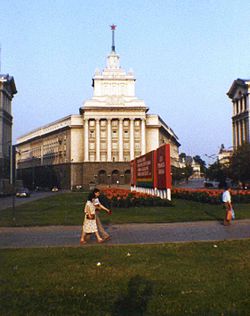Largo, Sofia
| Largo | |
Public square | |
| Length | 200 m (660 ft) |
|---|---|
| Width | 50 m |
| Location | Sofia, Bulgaria |
| Coordinates | 42°41′52″N 23°19′23″E / 42.69778°N 23.32306°E |
| Construction | |
| Completion | 1955 |
The Largo (
The Largo complex consists of three buildings around Independence Square: The Council of Ministers and the TSUM department store on the north side, the National Assembly (former Communist Party headquarters) with its iconic spire on the east side, the Presidential Administration (former Council of State) and the Balkan Hotel to the south side. Plans for a 16-storey City Hall on the east side, resembling the Moscow State University main building, were not carried out following de-Stalinisation.[2]
History
The yellow-cobblestoned square around which the ensemble is centred is called Independence Square. It is formed by the
The Party House building, once crowned by a
Refurbishment

Following the democratic changes after 1989, the symbols of communism in the decoration of the Largo were removed, with the most symbolic act being the removing of the red star on a pole atop the former Party House using a helicopter and its substitution by the flag of Bulgaria. In the 1990s there have been suggestions to reshape the former Party House, sometimes regarded as an imposing remnant of a past ideology,[4] by introducing more modern architectural elements.[5]
According to the new architectural plan of Sofia, Independence Square is as of 2006[update] being reorganized. The lawn and the flags in the centre are replaced by glass domes, so that the ruins of the ancient
Gallery
-
The former Party House in 1984, before the removal of the red star on spire
-
The former Party House in 2006
-
Council of Ministers
-
Presidential Administration
-
TZUM department store
-
The 4th-centurySt George Rotundabehind the Balkan Hotel
-
Presidential Guard
References
- ^ "Bulgaria Sofia Sights Around the Center of the Capital". monkeytravel.org. Archived from the original on February 27, 2006. Retrieved 2006-09-30.
- ^ Stara Sofia (Old Sofia)
- ^ ISBN 954-617-011-9.
- ^ Todorov, Petar; Mihail Konstantinov (2001-01-10). "Glass Dome Project". Demokratsiya. Archived from the original on 2011-07-06. Retrieved 2006-09-30.
- ^ Panchev, Lyubomir (2006-08-19). "Pro and con the reorganization of the Party House" (in Bulgarian). Duma. Archived from the original on September 29, 2007. Retrieved 2006-09-30.
- ^ a b Aleksandrova, Nina (2006-09-04). "The Largo is to be covered by a glass lid" (in Bulgarian). Standart News. Archived from the original on 2007-09-30. Retrieved 2006-09-30.







